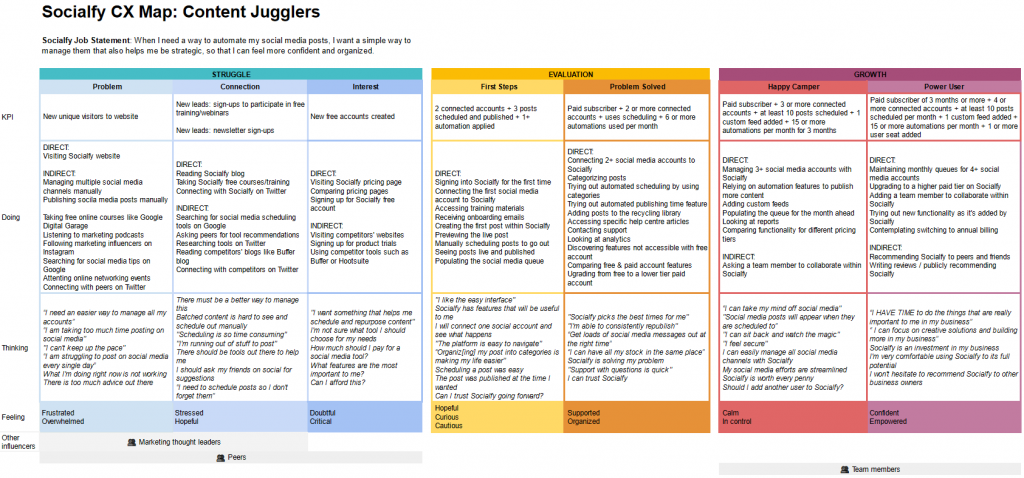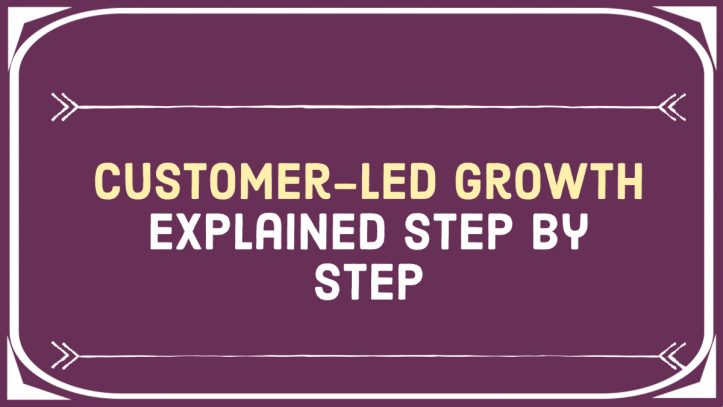Updated on November 25, 2024
Published on September 1, 2021
The philosophy behind Customer-Led Growth is simple: know who your ideal customer is and build your company around serving them. Get better at it. Rinse and repeat.
This is also a general enough, lofty goal that needs way more nuance to be put into practice.
So, when you decide to use the Customer-Led Growth framework to address various business opportunities you’ve got, what are you actually doing?
Broadly, there are four steps:
- The customer research phase 📝
- The Jobs to Be Done definitions phase 🚧
- Drawing of the Customer Experience Map(s) 🗺️
- The “So now what?” phase—decisions, action plans, implementation 💡
Let’s go through each of these one by one.
Customer Research
Everything customer-led must start with customer research. You cannot operate on your assumptions, educated guesses and even previous experience alone. You simply must talk to your customers.
While running customer interviews and surveys is the primary tool I recommend, there are many other sources of customer insight you may already have access to. Think sales call recordings, customer reviews, feedback, even publicly posted comments or questions.
Not all customer research is created equal. You need to know what questions to ask and what kind of information to extract for the research to be helpful and usable. Since Customer-Led Growth relies on the principles of Jobs to Be Done when building customer journey maps, you should let the JTBD theory guide you when conducting interviews and/or surveys as well.
Gather as much insight as you can and hear what your customers have to say, in their own words.
Jobs to Be Done
The Jobs to Be Done (JTBD) innovation theory has changed the way I look at marketing and I know it’s been the case for many amazing marketers out there too!
JTBD helps you understand why people buy—what “job” they are hiring your product to do. In any Job to Be Done, there is always a struggle, a motivation and a desired outcome present.
Motivation is what most companies focus on in their marketing, often forgetting the struggle and not emphasizing the desired outcome enough. But in JTBD, all three parts are equally important.
Customer-led growth cannot exist without you knowing your customer’s JTBD. Whether you are going through the process yourself or have a Customer-Led Growth consultant guiding you, you will need to do this work. Define the top Jobs your customers are hiring your product to do and then choose the top-priority one for your product.
Customer Experience Map
I like to call Customer-Led Growth brainy work 🧠 It often feels almost ephemeral and even theoretical until you start seeing the pieces of the puzzle come together for your unique business.
The Customer Experience (CX) Map drawing is where all this gets even brainier! This is also the point where the insight gathered and the Jobs to Be Done identified will converge with the practical everyday realities of your customers coming into contact with your product or service.
You will use everything you’ve got (and then some) to map out an actual customer journey for each JTBD you identified. One at a time please! Mapping is complicated and demanding work that has to be laser-focused on one Job.
What goes into a CX map?
The short answer: everything.
As the customer works through the process of realizing their problem to finding a solution that solves it, everything they do, think and feel will be reflected in your CX map.
It’s usually a combination of what already happens (if you have customers) and how you want it all to happen ideally, or “what good looks like” for you.
Here, you will also define the KPIs you will use to measure the successful transitions of your customer from one phase of the CX map to another. This is key—you’ll need to know whether what you’re doing is working!

Decisions, Decisions…
Once you have the CX map ready, it’s decision time. You have the full customer journey of your ideal customers right in front of you. What are you going to do with this information?
- What gaps have you identified, and what opportunities?
- Are there any low-hanging fruit?
- What can you improve for your customers with the least effort?
- Which changes would take more time but have a bigger payoff for serving them?
If you are working with a Customer-Led Growth consultant like myself, at this stage I would be drafting strategic recommendations for you based on everything learned in the previous phases of the project.
Depending on your needs as a client, the recommendations may include a messaging guide leaning on the customer research we’ve done, onboarding sequence recommendations, homepage revamps, additional marketing opportunities and more. All of them will centre your ideal customers and rely on their journeys to help your business grow in a sustainable way, long-term.
The Power of Customer-Led Growth
You can repeat this process for any specific problem or business opportunity. Most commonly, you would tackle other Jobs to Be Done you’ve identified and develop product and service improvements for customers with those Jobs.
The more you do it, the better and faster it gets!
For instance, depending on various deadlines and the responsiveness of a client’s customers, I can deliver the initial Customer-Led Growth project in under seven weeks. If this sounds like a long time, believe me, it’s not… because if you’re taking care of it in-house, it’s likely to take longer since you’re juggling other responsibilities. But it’s still worthwhile!
If you can, have a CLG consultant on your side so that you can be supported in the implementation. Operationalizing the philosophy of Customer-Led Growth will have lasting positive effects on how you serve your customers and grow your business.

